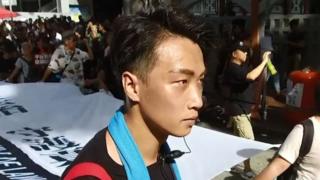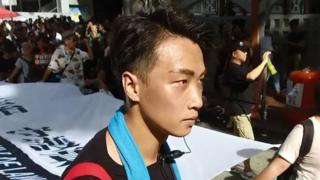Hong Kong protest leader Jimmy Sham ‘attacked with hammers’
Photographs show Jimmy Sham of the Civil Human Rights Front lying in the street, covered in blood. …


The leader of one of Hong Kong’s largest pro-democracy groups has been taken to hospital after being attacked.
Photographs on social media showed Jimmy Sham of the Civil Human Rights Front (CHRF) lying in the street, covered in blood.
Afterwards, the activist said he “remained committed to the ideal of peaceful non-violence”.
Mass protests in support of greater democracy in the territory, which began in June, show no sign of abating.
The attack on Mr Sham came hours after the territory’s leader suspended her annual address after being heckled in parliament.
What happened to Jimmy Sham?
The CHRF said he was set upon by a group of up to five hammer-wielding men in the Mong Kok district of the Kowloon peninsula, and left with head injuries.
It added that he was conscious as he was taken to hospital, and was in a stable condition.
It was the second time Mr Sham had been attacked since the protests began.
The CHRF linked the attack to government supporters, who are suspected of assaulting other pro-democracy activists in recent months.
“It is not hard to link this incident to a spreading political terror in order to threaten and inhibit the legitimate exercise of natural and legal rights,” it said in a statement.
Who is he?
Jimmy Sham is a long-time political activist in Hong Kong, mostly known for campaigning for LGBT rights.
In the anti-government protests he has been one of the leaders of the Civil Human Rights Front, one of the non-violent protest groups behind several of the huge marches since June.
The group said it was applying for a police permit to hold a new march on Sunday.
Its recent requests have been rejected, while more hardcore activists have held protests in defiance of bans and clashed with police.
While still in hospital, Mr Sham released a statement on Facebook, saying the attack “only enables me to connect even more” with fellow protesters.
He also thanked the police for swiftly arriving to help him and urged them to find who was behind the assault.
Amnesty International has urged the authorities to launch an investigation into the attack on Mr Sham.
“Jimmy Sham was left bleeding on the street and has been hospitalised with head injuries.
“Even in the context of increasing attacks on activists, this incident is shocking in its brutality,” said the head of the rights group’s East Asia regional office, Joshua Rosenzwei.
What happened in parliament on Wednesday?
Opposition lawmakers disrupted the Legislative Council (Legco) session as Hong Kong leader Carrie Lam tried to make her annual address.
After a first interruption, the session resumed only to be interrupted again.
It was then suspended – and a pre-recorded speech by Ms Lam was made available on the Legco website instead.
It was the first time a Hong Kong chief executive had been unable to deliver a policy address in the chamber.
It meant a controversial extradition bill – the trigger for the months of protests – could not be withdrawn formally.
During a news conference after the video address, Ms Lam rejected claims that her speech had ignored the demands of the protest movement.
But she said it was not the time to consider voting reform, while insisting Hong Kong did have freedom of speech and freedom of the press without Chinese interference.
What are the Hong Kong protests about?
Hong Kong is part of China but, as a former British colony, has some autonomy and people have more rights.
The protests started in June against plans to allow extradition to the mainland – which many feared would undermine the city’s freedoms and judicial independence.
The government in September promised the bill would be withdrawn once parliament resumed but demonstrations continued.
Protesters are now calling for five key demands:
- Don’t characterise the protests as “riots”
- Amnesty for arrested activists
- An independent inquiry into alleged police brutality
- Implementation of complete universal suffrage
- Withdrawal of the extradition bill
Protests have taken place every weekend over the past month and in every district, causing widespread disruption.
Clashes between police and activists have become increasingly violent, with police firing live bullets and protesters attacking officers and throwing petrol bombs.
How did the protests escalate?
- The first protest took place in June
- In July, protesters stormed Legco, spraying graffiti and defacing symbols
- In August, one protester was injured in the eye, leading to activists wearing eye patches to show solidarity
- Hundreds of flights from Hong Kong were cancelled that month after airport protests
- In September, Ms Lam announced she would withdraw the extradition bill but most protesters said it was “too little, too late”
- On 1 October, China celebrated 70 years of Communist Party rule and Hong Kong saw another day of violent clashes in which an 18-year-old was shot in the chest with a live bullet and protesters fought officers with poles, petrol bombs and other projectiles
- On 4 October the government banned face masks, invoking powers dating back to colonial rule
- Last Sunday, peaceful rallies again descended into clashes with railway stations and shops deemed to be pro-Beijing targeted.




